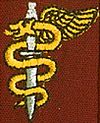
A paratrooper is a military parachutist—someone trained to parachute into a military operation, and usually functioning as part of airborne forces. Military parachutists (troops) and parachutes were first used on a large scale during World War II for troop distribution and transportation. Paratroopers are often used in surprise attacks, to seize strategic objectives such as airfields or bridges.
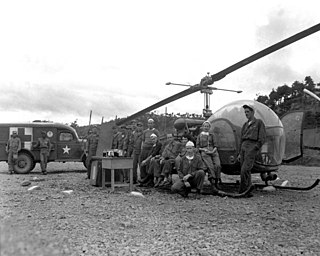
Mobile Army Surgical Hospitals (MASH) were U.S. Army field hospital units conceptualized in 1946 as replacements for the obsolete World War II-era Auxiliary Surgical Group hospital units. MASH units were in operation from the Korean War to the Gulf War before being phased out in the early 2000s. Each MASH unit had 60 beds, as well as surgical, nursing, and other enlisted and officer staff available at all times. MASH units filled a vital role in military medicine by providing support to army units upwards of 10,000 to 20,000 soldiers. These units had a low mortality rate compared to others, as the transportation time to hospitals was shorter, resulting in fewer patients dying within the "Golden Hour", the first hour after an injury is first sustained, which is referred to in trauma as the "most important hour". The U.S. Army deactivated the last MASH unit on February 16, 2006, and the successors to Mobile Army Surgical Hospitals are combat support hospitals.
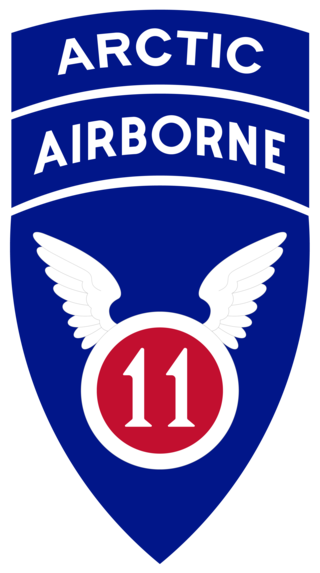
The 11th Airborne Division is a United States Army airborne formation based in Alaska.

A Combat Support Hospital is a type of modern United States Army field hospital. The CSH is transportable by aircraft and trucks and is normally delivered to the Corps Support Area in standard military-owned demountable containers (MILVAN) cargo containers. Once transported, it is assembled by the staff into a tent hospital to treat patients. Depending upon the operational environment, a CSH might also treat civilians and wounded enemy soldiers. The CSH is the successor to the Mobile Army Surgical Hospital (MASH).

44 Parachute Regiment is the South African Army's chief airborne infantry unit. It was created in 2000 by redesignating 44 Parachute Brigade, and is based at the Tempe military base near Bloemfontein.

The Canadian Airborne Regiment was a Canadian Forces formation created on April 8, 1968. It was not an administrative regiment in the commonly accepted British Commonwealth sense, but rather a tactical formation manned from other regiments and branches. It was disbanded in 1995 after the Somalia affair.

A combat medic is responsible for providing emergency medical treatment at a point of wounding in a combat or training environment, as well as primary care and health protection and evacuation from a point of injury or illness. Additionally, medics may also be responsible for the creation, oversight, and execution of long-term patient care plans in consultation with or in the absence of a readily available doctor or advanced practice provider. Combat medics may be used in hospitals and clinics, where they have the opportunity to work in additional roles, such as operating medical and laboratory equipment and performing and assisting with procedures.

Para (Special Forces), also known as Para Commandos or Para (SF) Commandos, is a group of special forces battalions of the Parachute Regiment in the Indian Army. These units specialize in various roles including counter-terrorism, hostage rescue, unconventional warfare, special reconnaissance, counter-insurgency and direct action.

The 10th Parachute Brigade, abbreviated as 10 PARA BDE, is an elite division-sized hybrid airborne-marine unit within the Malaysian Army. It is tasked with rapid reaction forces inside or outside the boundaries of Malaysia and serves as the key element of the Malaysian Rapid Deployment Force.

The 4th Battalion, Parachute Regiment, is an Army Reserve unit of the British Army. Now recruiting across the United Kingdom originally the Battalion covered the North of England, with its headquarters located in Pudsey, West Yorkshire. Following the Options for Change review in 1993, 4 PARA amalgamated with the 15th (Scottish) Battalion of the Parachute Regiment, which was downsized and became 15 (Scottish) Company of 4 PARA. As part of further changes in 1999, the Battalion also merged with the 10th (Volunteer) Battalion which then became 10 (London) Company.
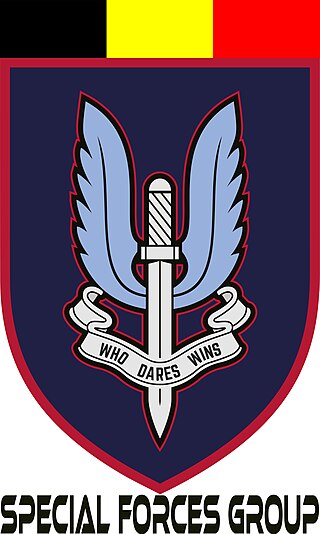
The Special Forces Group is the special forces unit in the Land Component of the Belgian Armed Forces.

The 1st Health Battalion is a unit of the 2nd Health Brigade. It is headquartered at the Robertson Army Barracks in Darwin. Formally having sub-units located in Darwin, Townsville and Brisbane, the then 1CHB was raised as 1 HB and fell under the command of the reestablished 2nd Health Brigade in 2022; with the existing Sub-Units being absorbed into 4th Health Battalion (Australia), and 2nd Health Battalion (Australia), respectfully. Additionally, a Close Health Unit was founded under the command of the 3rd Health Battalion (Australia), cementing the new capabilities of Joint Health.

7 Medical Battalion Group is the specialist Airborne Medical Unit of the South African Military Health Service. The Battalion's main task is to render medical support to the South African Airborne and Special Forces. The unit falls under the command of the Mobile Military Health Formation.
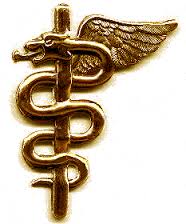
The Operational Medical Orderly, better known as the Ops Medic is the collective name for the South African Defence Forces Operationally trained Medics. The Ops refers to the Operational area and was used to indicate that the medical orderlies deployed to the Operational area or theatre of operations of the then South African Defence Force (SADF). The Operational area referred to the border or cutline between Namibia and Angola where the Angolan Bush War conflict or border war was taking place from the 1970s to 1989.

44 Parachute Brigade was a parachute infantry brigade of the South African Army. It was founded on 20 April 1978, by Colonel Jan Breytenbach, following the disbandment of 1 SA Corps and the battle of Cassinga. Upon formation, the brigade was commanded by Brigadier M. J. du Plessis, who was assigned the task of establishing by working with the Parachute Staff Officer, Colonel Jan Breytenbach. At the time du Plessis was the commanding officer of the Orange Free State Command and had previous experience serving in 1 Parachute Battalion. Breytenbach had also been a member of 1 Parachute Battalion and had also founded the South African Special Forces Brigade and 32 Battalion. The location that was chosen for the brigade's headquarters was in the lines of the OFS Cmd Headquarters, next to the old Tempe Airfield in Bloemfontein.
68W is the Military Occupational Specialty (MOS) for the United States Army's Combat Medic. 68Ws are primarily responsible for providing emergency medical treatment at point of wounding on the battlefield, limited primary care, and health protection and evacuation from a point of injury or illness. 68Ws are certified as Emergency Medical Technicians (EMT) through the National Registry of Emergency Medical Technicians (NREMT). However, 68Ws often have a scope of practice much wider than that of civilian EMTs. This specialty is open to males and females with minimum line scores of 107 GT and 101 ST on the Armed Services Vocational Aptitude Battery (ASVAB).

The Para-Commando Brigade was an elite force in the Belgian Land Component, consisting of two paracommando battalions, the Special Forces Group and a support unit of the Communication & Information Systems Group (CIS). In 2003, its name was changed to the Light Brigade. On 3 July 2018, the Light Brigade was renamed and transformed into the Special Operations Regiment.

1 Parachute Battalion is the only full-time paratroop unit of the South African Army. It was founded on 1 April 1961, along with the Parachute Battalion. The name of this unit was changed to Parachute Training Centre after 1998. It was the first battalion within 44 Parachute Brigade until 1999 when the brigade was downsized to 44 Parachute Regiment

The Steve Biko Artillery Regiment is a airborne artillery regiment of the South African Artillery.

The 44 Pathfinder Platoon is part of the 44 Parachute Regiment. The pathfinder is a trained and specialized paratrooper, who performs covertly behind enemy lines, either in small groups or in collaboration with other reconnaissance units.

